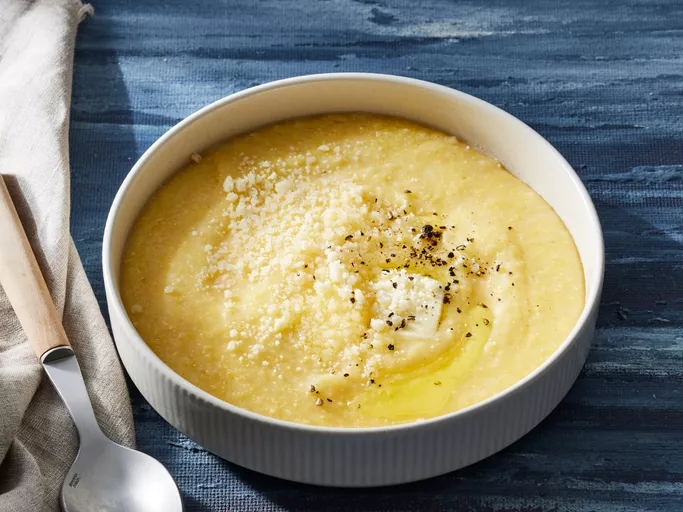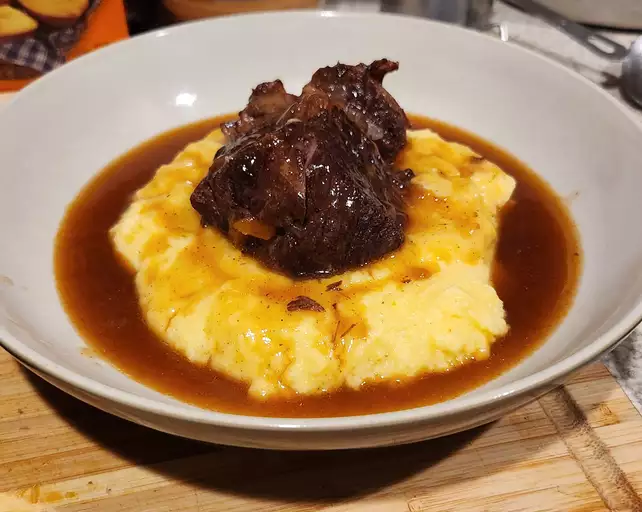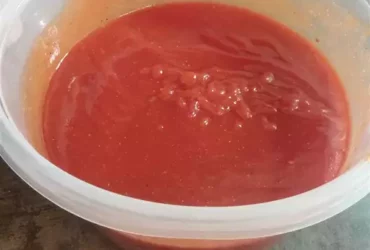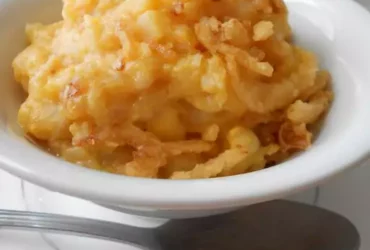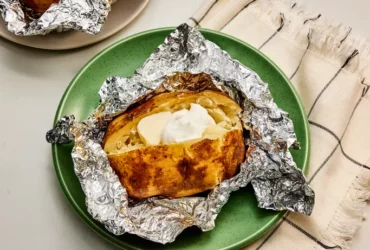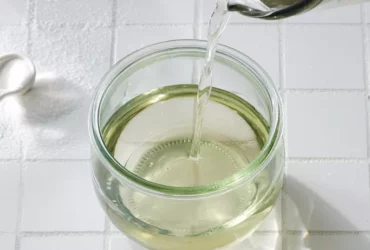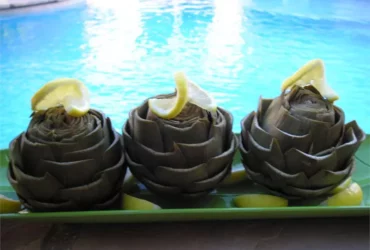Choosing the Right Cornmeal
Select a Coarse or Medium-Ground Polenta Cornmeal
To make perfect polenta, you’ll need to choose the right type of cornmeal.
The two most common types of cornmeal are fine-ground and coarse- or medium-ground polenta cornmeal.
Fine-ground cornmeal is made from corn that has been finely ground into a powdery texture, making it ideal for baking and cooking delicate recipes like cakes and cookies. However, this type of cornmeal does not hold its shape well when cooked and can become mushy or sticky.
On the other hand, coarse- or medium-ground polenta cornmeal is made from corn that has been coarsely ground into a slightly chunky texture. This type of cornmeal is specifically designed for making polenta and holds its shape well when cooked, creating a creamy and comforting dish.
If you want to make traditional Italian-style polenta, choose a coarse-ground polenta cornmeal with large, visible particles that will give your polenta a hearty texture. A medium-ground cornmeal is also a good option if you prefer a slightly softer polenta.
When selecting a cornmeal for polenta, look for brands that are labeled as polenta cornmeal or entirely stone-ground cornmeal, which ensures that the corn has been ground using traditional methods and not refined with added chemicals or preservatives.
Remember to store your cornmeal in an airtight container to keep it fresh and prevent it from becoming rancid, so you can enjoy making perfect polenta every time!
A coarse grind is best for traditional, creamy polenta
When it comes to choosing the right cornmeal for making perfect polenta, selecting a coarse grind is essential for achieving the traditional creamy texture.
The primary reason for this is that fine or medium-grind cornmeal can result in a porridge-like consistency rather than the velvety smoothness characteristic of authentic polenta.
Polenta made with a coarse grind cornmeal allows for better absorption and blending of liquid during cooking, which helps to create an even and creamy texture.
Look for cornmeal that is labeled as ‘stone-ground’ or ‘medium-coarse grind,’ as these are typically milled from larger stones and will yield the desired texture.
Avoid using fine-grind cornmeal, also known as superfine or polenta meal, as this type of cornmeal can produce a thin, almost porridge-like consistency when cooked with liquid.
Some brands may label their coarse grind cornmeal as medium-coarse or coarse stone-ground; this is also suitable for making authentic polenta.
Keep in mind that different types of corn, such as dryland corn or southern yellow corn, may produce slightly varying textures when ground and cooked.
For traditional creamy polenta, stick with coarse grind cornmeal to achieve the authentic texture that this beloved Italian dish is known for.
A medium grind works well for firmer, more rustic polenta
- Certain types of cornmeal are better suited for making perfect polenta, and it’s essential to choose the right one to achieve the desired texture and flavor.
- The main types of cornmeal used for polenta are medium, fine, and stone-ground.
- Medium grind cornmeal is an excellent choice for firmer, more rustic polenta. It provides a good balance between texture and cooking time, resulting in a deliciously chewy consistency.
- Here’s how to choose the right cornmeal:
Medium Grind Cornmeal
A medium grind is perfect for those who prefer a firmer polenta with a slightly coarser texture. It cooks relatively quickly, usually within 20-25 minutes.
Fine Grind Cornmeal
Fine grind cornmeal yields a softer and more delicate polenta. If you’re looking to create a creamier polenta, this might be the better option for you. Keep in mind that it cooks faster than medium grind cornmeal, typically within 10-15 minutes.
Stone-Ground Cornmeal
Stone-ground cornmeal provides an incredibly coarse texture and can add a nutty flavor to your polenta. If you’re looking for a more rustic, artisanal taste experience, this is the perfect choice. However, it cooks much slower than medium or fine grind cornmeal, often taking around 45 minutes to an hour.
When shopping for cornmeal, ensure that it’s labeled as “polenta cornmeal” or “corn grits” – some brands use these terms interchangeably, but they all contain finely ground corn kernels.
Ultimately, the choice of cornmeal depends on personal preference and the desired texture of your polenta. Experiment with different types to find your perfect match!
Cooking the Polenta
Ratio of Water to Cornmeal: 4:1
To cook perfect polenta, it’s essential to get the ratio of water to cornmeal just right. The ideal ratio is 4:1, with 4 parts water to 1 part cornmeal. This will give you a creamy and smooth polenta that’s not too thick or too thin.
Start by bringing the water to a boil in a medium saucepan. Add 1 cup of medium grind cornmeal, whisking constantly to prevent lumps from forming.
Reduce the heat to low and continue to cook, stirring frequently, for about 5-7 minutes or until the polenta has thickened and come away from the sides of the pan. You’ll know it’s ready when it has a creamy consistency and a slightly firm texture in the center.
Once the polenta is cooked, remove it from the heat and let it rest for a minute or two before serving. This will help it to set and become even creamier.
Tips for perfect polenta: use high-quality cornmeal that’s freshly ground, use a ratio of 4:1 water to cornmeal, whisk constantly when adding the cornmeal to prevent lumps from forming, and stir frequently as the polenta cooks to ensure it thickens evenly.
According to the USDA, this ratio yields a perfect balance of texture and flavor
The key to cooking polenta lies in achieving the right balance of texture and flavor, which can be achieved by using a specific ratio of liquid to cornmeal according to the USDA. A classic recipe for making perfect polenta involves using 4 cups of water or broth to every 1 cup of medium grind yellow cornmeal.
Before starting to cook, it’s essential to have all the necessary ingredients and equipment within reach. This includes a large heavy-bottomed pot with a heavy bottom, preferably made of stainless steel, enameled cast iron, or copper, as these materials retain heat well and help to prevent scorching.
Start by bringing the water or broth to a boil in the pot over high heat. Once it reaches a rolling boil, gradually add the cornmeal while continuously whisking the mixture with a wooden spoon to prevent lumps from forming.
Reduce the heat to medium and continue cooking for about 5-7 minutes, stirring frequently until the polenta has thickened and reached your desired consistency. If you prefer a softer polenta, cook it for another 2-3 minutes; if you prefer a thicker, creamier polenta, cook it for an additional 5 minutes or more.
It’s essential to stir the polenta frequently during cooking to prevent scorching and ensure that it cooks evenly. If you notice any lumps forming, don’t worry – simply continue whisking until they break down.
After the polenta has reached your desired consistency, remove it from heat and add in any flavorings or seasonings of your choice. These can include grated cheese, herbs, spices, or even a drizzle of olive oil.
Once you’ve added your chosen toppings, transfer the polenta to individual serving dishes or a large serving platter, and serve immediately while still warm. If you’re not serving it right away, you can let it rest in the pot for about 30 minutes to allow the flavors to meld together before reheating it.
By following these simple steps and using the recommended ratio of liquid to cornmeal, you’ll be able to create a deliciously creamy polenta that’s sure to become a staple in your kitchen.
Bring water to a boil before slowly whisking in cornmeal
- To cook the perfect polenta, begin by bringing a large pot of water to a boil.
- Once the water has reached its boiling point, reduce the heat to a simmer and add 2-3 cups of cornmeal, whisking continuously to prevent lumps from forming.
- The key here is to slowly whisk in the cornmeal, as adding it too quickly can cause the mixture to become lumpy and difficult to cook evenly.
- Continue cooking the polenta for about 20-25 minutes, or until it has reached your desired consistency.
- You may need to stir the pot occasionally to prevent the polenta from sticking to the bottom.
- If you prefer a creamy and smooth texture, cook the polenta for 5-10 minutes longer.
- Season the polenta with salt and any other desired flavorings, such as herbs or spices, before serving.
- Enjoy your perfectly cooked polenta!
Tips for Achieving Perfect Texture
Stir Consistently and Monitor Temperature
- To achieve perfect texture when making polenta, it’s crucial to stir the mixture consistently throughout the cooking process.
- This helps to prevent lumps from forming and ensures a smooth, creamy consistency in your finished dish.
- Begin by heating a medium saucepan over medium heat, then gradually add in your chosen polenta type (such as cornmeal or semolina).
- Stir the mixture constantly using a silicone or wooden spoon until it reaches a simmer state, taking care not to let it come to a full bubble.
- Reduce the heat to low and continue stirring every minute or so for approximately 20-25 minutes.
- This is where patience truly comes into play – you’ll need to maintain that steady stream of heat and stir consistently without letting your attention waver.
- The temperature you’re aiming for here should be between 180°F (82°C) and 190°F (88°C) – any lower, and the polenta won’t set properly, while anything higher might cause it to become overcooked.
- When your desired temperature is reached, remove the saucepan from the heat source and let it rest for a couple minutes.
- This brief pause in cooking time allows any excess water to drain away and the polenta to firm up slightly – giving you that perfect texture you’ve been working towards!
Stir polenta frequently to prevent lumps from forming
To achieve perfect texture when making polenta, it’s essential to pay attention to a few key factors throughout the cooking process.
Stir Polenta Frequently
Stirring your polenta frequently will help prevent lumps from forming and ensure that the mixture cooks evenly. A wooden spoon or silicone spatula is ideal for this task.
Don’t Overmix
While stirring is necessary, overmixing can lead to a dense, glue-like texture. Mix just until the ingredients are combined and then stop.
Choose the Right Ratio
The ratio of cornmeal to liquid is crucial in achieving the right texture. A general rule of thumb is 4 cups of water for every 1 cup of polenta. However, this can be adjusted depending on your personal preference.
Use the Right Type of Cornmeal
There are two main types of cornmeal: fine and coarse. Fine cornmeal will yield a creamier polenta, while coarse cornmeal will give you a heartier, more rustic texture. Choose the right type for your desired outcome.
Bonus Tips:
Add Flavor with Herbs and Spices
Add a pinch of salt, some chopped herbs like parsley or rosemary, or a sprinkle of grated cheese to give your polenta an extra boost of flavor.
Don’t Overcook
Cook the polenta until it reaches the desired consistency. If you overcook it, it will be too dry and crumbly. Aim for a creamy, tender texture.
Add Moisture with Broth or Stock
Adding some broth or stock can help maintain the moisture levels of your polenta, preventing it from drying out. Just be mindful not to add too much liquid, as this can make the mixture too runny.
Keep the temperature at 180190°F (8288°C) for a smooth, creamy finish
To achieve perfect texture in your polenta recipe, it’s essential to focus on a few key factors during preparation and cooking.
First, choose the right type of cornmeal for your polenta. A medium or coarse grind cornmeal will give you the best results, as these textures will allow for a smooth yet creamy finish. Avoid using fine-grind cornmeal, as it can result in a gummy or sticky consistency.
Next, ensure that your ingredients are at room temperature before starting to cook. This helps prevent uneven cooking and ensures that your polenta develops the right texture from the outset.
Now, let’s discuss the importance of heat and temperature during cooking. To achieve a smooth, creamy finish in your polenta, it’s crucial to maintain a consistent temperature between 180°F (82°C) and 190°F (88°C). This range will help prevent overcooking or burning your polenta.
Additionally, be sure to stir the polenta frequently during cooking. Regular stirring will ensure that the cornmeal cooks evenly and doesn’t form any lumps or hotspots. A wooden spoon is an excellent tool for this task, as it won’t scratch the pot and can help prevent over-mixing.
Another key factor in achieving perfect texture is to cook your polenta to the right consistency. This can vary depending on personal preference, but a good starting point is to aim for a polenta that’s cooked for around 20-25 minutes or until it reaches a creamy yet firm consistency. Avoid overcooking your polenta, as this will result in a dry and crumbly texture.
Finally, be mindful of the liquid-to-cornmeal ratio when making your polenta recipe. A general rule of thumb is to use 4-6 cups of water or broth for every cup of cornmeal. This will help create a smooth and creamy finish without becoming too watery or thin.
- Best Datanyze Alternatives for 2025 - April 24, 2025
- Best Hunter.io Alternatives for 2025 - April 22, 2025
- Best Lead411 Alternatives for 2025 - April 22, 2025

